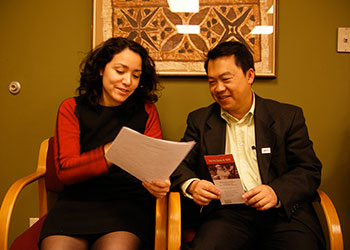This fact sheet is current as of May 4, 2022.
Click here for a printable PDF version of this fact sheet.
On Wednesday, May 4, 2022, U.S. Citizenship and Immigration Services (USCIS) announced a Temporary Final Rule (TFR) that increases the automatic extension period for Employment Authorization Documents (EADs) to 540 days for certain EAD renewal applicants. The increase, which is effective immediately on May 4, 2022, will help avoid gaps in employment for noncitizens with pending EAD renewal applications.
This extension, applies to those EAD categories currently eligible for an automatic up to 180 day extension, will temporarily provide an additional 360 days of EAD extension time (for a total of up to 540 days) to eligible applicants with a timely-filed Form I-765 EAD renewal application. Note–No new EAD categories have been added for the automatic EAD extension.
Who does this new rule affect?
There are four situations in which this NEW extension will affect noncitizen applicants:
- Certain noncitizens with pending EAD renewal applications and expired EADs
Noncitizens with a pending EAD renewal application whose 180 day automatic extension has lapsed and whose EAD has expired will be granted an additional period of employment authorization and EAD validity, beginning on May 4, 2022, and lasting up to 540 days from the expiration date of their EAD. They may resume employment if they are still within the 540 day automatic extension period and are otherwise eligible.
- Noncitizens with pending EAD renewal applications who are covered by the 180 day extension
Noncitizens with a pending EAD renewal application still covered under the 180 day automatic extension will be granted an additional 360 day extension, for a total of up to 540 days past the expiration of the current EAD.
- Noncitizens with pending EAD renewal applications AND valid EADs on May 4, 2022
Noncitizens with a pending EAD renewal application and valid EAD on May 4, 2022, will be granted an automatic extension of up to 540 days if their EAD expires before the renewal application is processed.
- Noncitizens who timely file an EAD renewal application before October 27, 2023
Noncitizens who timely file an EAD renewal application before Oct. 27, 2023, will be granted an automatic extension of up to 540 days if their EAD expires before the renewal application is processed.
Who is Eligible for this Extension?
The following employment eligible categories are eligible for an automatic EAD extension:
| The eligibility category you listed on your Form I-765 renewal application |
Description |
| (a)(3) |
Refugee |
| (a)(5) |
Asylee |
| (a)(7) |
N-8 or N-9 |
| (a)(8) |
Citizen of Micronesia, Marshall Islands, or Palau |
| (a)(10) |
Withholding of Deportation or Removal Granted |
| (a)(12) |
Temporary Protected Status (TPS) Granted |
| (a)(17) |
Spouse of principal E nonimmigrant with an unexpired I-94 showing E (including E-1S, E-2S and E-3S) nonimmigrant status* |
| (a)(18) |
Spouse of principal L-1 Nonimmigrant with an unexpired I-94 showing L-2 (including L-2S) nonimmigrant status* |
| (c)(8) |
Asylum Application Pending |
| (c)(9) |
Pending Adjustment of Status under Section 245 of the Act |
| (c)(10) |
Suspension of Deportation Applicants (filed before April 1, 1997)
Cancellation of Removal Applicants
Special Rule Cancellation of Removal Applicants Under NACARA |
| (c)(16) |
Creation of Record (Adjustment Based on Continuous Residence Since January 1, 1972) |
| (c)(19) |
Pending initial application for TPS where USCIS determines applicant is prima facie eligible for TPS and can receive an EAD as a “temporary treatment benefit”. |
| (c)(20) |
Section 210 Legalization (pending I-700) |
| (c)(22) |
Section 245A Legalization (pending I-687) |
| (c)(24) |
LIFE Legalization |
| (c)(26) |
Spouses of certain H-1B principal nonimmigrants with an unexpired I-94 showing H-4 nonimmigrant status |
| (c)(31) |
VAWA Self-Petitioners |
What documents can be used to prove employment authorization?
- Form I-797C Notice of Action AND the Expired EAD for I-765s filed on or after May 4, 2022
Noncitizens who file a Form I-765 renewal application on or after May 4, 2022, will receive a Form I-797C Notice of Action receipt notice that has information regarding the up to 540 day automatic extension. If they are eligible for the automatic extension, this receipt notice, together with their expired EAD serve as acceptable proof of employment authorization and/or EAD validity during the up to 540 day automatic extension period.
- Form I-797C Notice of Action for I-765s filed before May 4, 2022
Noncitizens who filed a Form I-765 renewal application before May 4, 2022, should have received a Form I-797C Notice of Action receipt notice that describes the automatic extension period of up to 180 days. They will not receive a new I-797C receipt notice reflecting the increased employment authorization and/or EAD automatic extension period. However, Form I-797C receipt notices that refer to an up to 180 day automatic extension will still meet the regulatory requirements for completing Form I-9, including if their 180 day automatic extension expired prior to May 4, 2022.
When does the extension end?
The automatic EAD extension generally will end upon a final decision on the renewal application or the end of the up to 540 day period (meaning, up to 540 days after the expiration date on the applicant’s facially expired EAD), whichever comes earlier.
Beginning October 27, 2023, automatic extensions of employment authorization and EAD validity will change back to the up to 180 day period for those eligible applicants who timely file Form I-765 renewal applications.
For Employers
This rule does not modify the current requirements an employer must follow for Form I-9 at 8 CFR 274a.2(b)(1)(vii) that apply to automatic extensions, except that this rule temporarily replaces “180” with “540” in its reference to the maximum number of days for the automatic extension period. Therefore, when an employee chooses to use an EAD and Form I-797C receipt notice as provided under this rule to complete Form I-9 for new employment, the employee and employer should use the extended expiration date to complete Section 1 (if applicable) and Section 2 of the Form I-9 and reverify no later than the date that the automatic extension period expires.
For current employment, the employer should update the previously completed Form I-9 to reflect the extended expiration date based on the automatic EAD extension while the renewal is pending and reverify no later than the date that the automatic extension expires.
For renewal applicants with pending Forms I-765 who experienced a lapse in employment authorization and/or EAD validity prior to the effective date of this rule, May 4, 2022, yet resume a period of employment authorization and/or EAD validity under this rule, and are rehired by the same employer, their employers must complete Form I-9 by treating the individual’s employment authorization as having previously expired pursuant to 8 CFR 274a.2(c)(1)(ii) but have a choice of either reverifying employment authorization on the employee’s Form I-9 or completing a new Form I-9.
Get Help
The Immigrant Law Center of Minnesota (ILCM) provides free immigration legal services to low-income immigrants in a variety of immigration matters. For more information about how we can assist you, please visit our website at www.ilcm.org or call us at (651) 641-1011.








